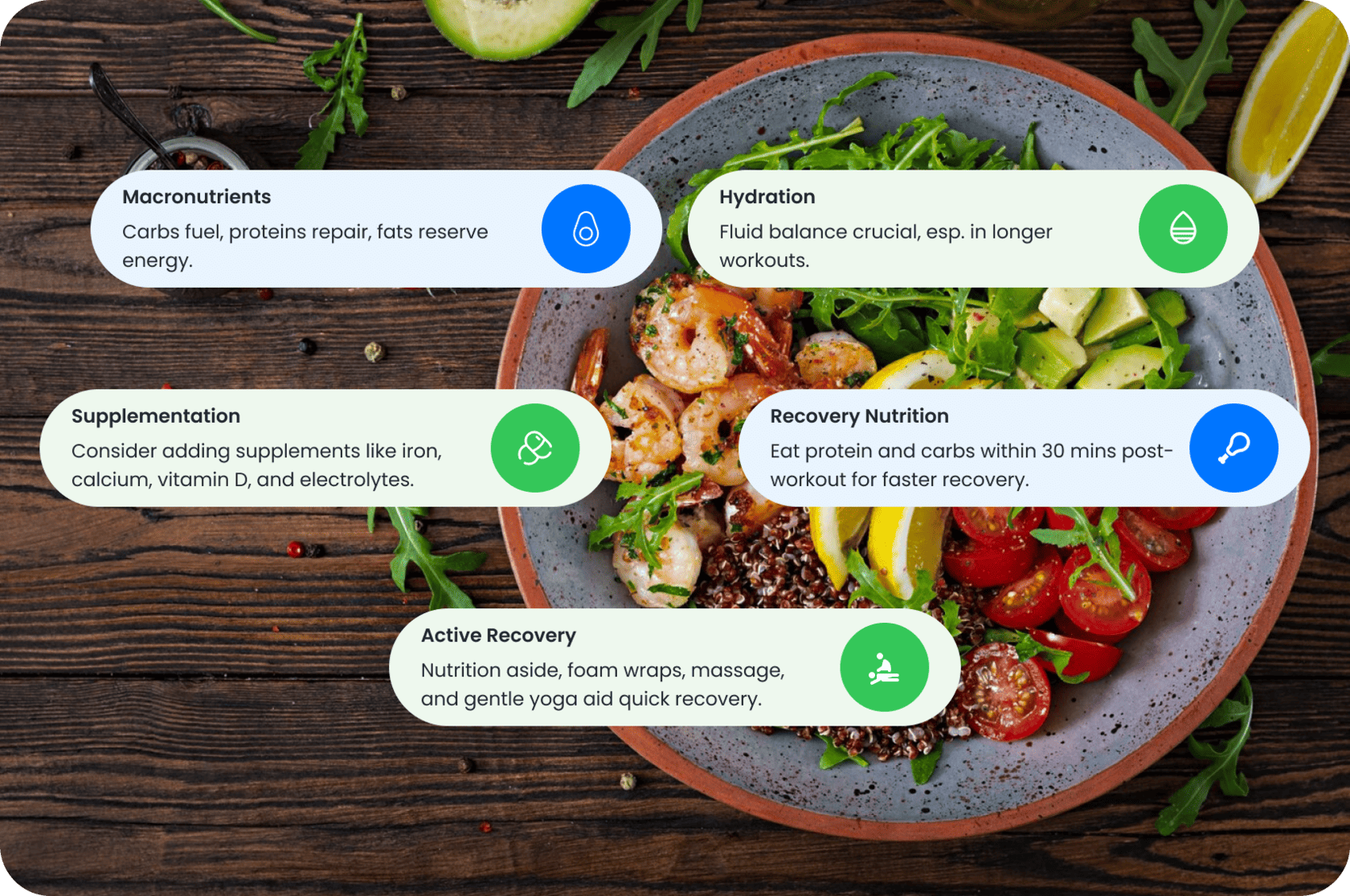The Ironman Triathlon, a grueling test of endurance, has captivated athletes for decades.
The allure of swimming 2.4 miles, biking 112 miles, and running 26.2 miles in succession pushes athletes to the edge of their physical and mental capacities.
To conquer this behemoth of a race, the right training schedule, like the one we’ve shared in this 6-month Ironman training plan guide, is paramount.
This guide covers individualized training plans for everyone, from beginners to elite triathletes.
This ensures that you are prepared for optimal performance for the upcoming Ironman events.
Ironman Triathlon: Distance, Discipline, and Dedication
The Ironman is not just another race.
This full-distance triathlon demands a holistic approach, merging intense physical training with mental fortitude.
Ironman triathlon consists of the following components:
1. Swimming
A 2.4-mile swim, often in open waters. Navigating waves, currents, and other swimmers requires not only strength but also strategy.
2. Biking
112 miles in the saddle requires impeccable cardiovascular fitness. Specifically, leg strength and cycling technique.
3. Running
The 26.2-mile marathon at the end can be the most grueling, as fatigue sets in and every muscle screams for rest.
Realizing the magnitude of the challenge, specialized Ironman training plans are not just useful. They become essential.
Key Components of an Effective Triathlon Training Plan
A well-crafted Ironman triathlon training plan encompasses several elements:
1. Periodization
Most training plans adopt a periodized approach, segmented into Base, Build, Peak, and Taper phases. This systematic progression optimizes performance while minimizing injury risks. Here is how the training year will look, when your training incorporates Norwegian method periodization:
Base Phase
This initial phase focuses on building aerobic endurance and establishing a solid foundation. Workouts typically have low to moderate intensity and longer duration.
Build Phase
Intensity increases during this phase, emphasizing specific training to improve speed, strength, and endurance. Workouts become more race-specific.
Peak Phase
Intensity peaks during this phase, aiming to reach the highest level of fitness just before the race. Workouts often include race simulations and tapering begins towards the end.
Taper Phase
This phase reduces training volume while maintaining intensity, allowing the body to recover fully and peak on race day. It’s about balancing rest and maintaining fitness. If you are getting ready for the marathon, check out this guide on how to taper a marathon.
2. Strength and Conditioning
Beyond discipline-specific training, enhancing overall body strength aids performance and wards off injuries.
- Functional strength training: Exercises that target muscle groups used in swimming, cycling, and running help improve performance and prevent injuries.
- Core stability: A strong core improves posture, balance, and efficiency in all three disciplines of the triathlon.
- Flexibility: Stretching and mobility exercises enhance range of motion, reducing the risk of overuse injuries.
3. Recovery
Efficient recovery is arguably as vital as training itself. Sufficient rest, active recovery sessions, and sleep are pivotal for muscle repair and growth:
- Rest days: Scheduled days off from training are crucial for allowing the body to recover and adapt to the stress of training.
- Active recovery: Low-intensity activities like walking, yoga, or swimming can aid in recovery by promoting blood flow and flushing out metabolic waste products.
- Sleep: Quality sleep is essential for muscle repair, hormone regulation, and overall well-being. Aim for 7-9 hours of sleep per night.
4. Nutrition and Hydration
Keeping the body adequately fueled and hydrated ensures sustained energy levels throughout the rigorous training and the race.
- Balanced diet: A diet rich in carbohydrates, proteins, healthy fats, vitamins, and minerals supports training adaptations and enhances recovery.
- Hydration: Proper hydration is vital for regulating body temperature, maintaining electrolyte balance, and preventing dehydration. Drink water consistently throughout the day and during training sessions.
- Nutrition timing: Consuming carbohydrates and protein before, during, and after workouts optimizes energy levels, muscle repair, and glycogen replenishment.
Ironman Training for Novices: Getting Started
For first-timers, the Ironman journey can appear daunting.
However, with the right approach, the impossible becomes attainable. Here’s a roadmap:
1. Set Clear Goals
Understand why you’re pursuing the Ironman races. Whether it’s a personal challenge or a bucket list item, clarity propels motivation.
2. Begin Slowly
Novice plans often span 6-9 months, starting with low intensities and shorter durations. For example, in the initial weeks, you can practice swimming 400 meters, biking for 30 minutes, and running 1-2 miles.
3. Avoid Common Pitfalls
Overtraining and inadequate recovery top the list. Remember, consistency trumps intensity.
Intermediate Training: Pushing Past Plateaus
For those who have already finished a couple of Sprints or an Olympic triathlon, intermediate triathlon training plans offer the next challenge.
Let’s see how your training plan will differ from a beginner’s one.
1. Intensify and Diversify
Now, sessions have become longer and more varied. Incorporate hill workouts, interval runs, and open-water swims.
2. Technique Tuning
Efficiency in each discipline is crucial. This might mean refining your swim stroke, optimizing bike posture, or tweaking running mechanics.
3. Race Simulations
Periodically, mimic race conditions. Back-to-back swim-bike or bike-run sessions, known as “brick workouts,” simulate race day transitions.
Veteran Insights
Ironman distance finisher John shares, “It’s during the intermediate phase that mental tenacity truly gets tested. Embrace it. Every tough session is a step closer to the finish line.”
Elite Training: The Pursuit of Perfection
The upper echelons of triathlon performance demand more than just increased training hours. Let’s dive into the intricacies of a structured training plan for Ironman.
1. Precision-Driven Workouts
Elite Ironman athletes often undergo VO2 max and lactate threshold testing. This is necessary to customize their training zones.
This data helps coaches tailor their Ironman training guide to the individual athlete’s capabilities, ensuring workouts are optimized for maximal performance gains.
Based on test results, specific training zones are established for various intensities ranging from easy recovery efforts to maximal efforts.
Training within these zones ensures that athletes are working at the appropriate intensity to elicit desired physiological adaptations.
2. High-Intensity Sessions
Elite triathlon training plan incorporates high-intensity interval training (HIIT) into their programs to improve aerobic and anaerobic capacity, muscular endurance, and race-specific fitness.
For example, a typical cycling interval session might involve riding at or slightly above race pace for a set duration followed by a short recovery period. This challenges the cardiovascular system and helps simulate race conditions.
Training sessions are meticulously planned and structured to target specific physiological systems and performance metrics. This includes varying intensities, durations, and recovery periods to elicit desired adaptations and prevent overtraining.
3. Sports Science
Utilizing technology, from power meters to advanced biomechanical analysis, gives elites the edge.
Elite Insights: World Champion Jan Frodeno once said, “In training, listen to your body. In competition, tell it to shut up!”
Jan Frodeno’s quote highlights the importance of listening to the body during training while also pushing its limits in competition.
Elite athletes develop a deep understanding of their physical and mental capabilities, learning when to push through discomfort and when to prioritize recovery to achieve peak performance on race day. This mindset, coupled with precision training and cutting-edge sports science, is key to achieving excellence in triathlon at the highest level.
Athletes also leverage cutting-edge sports science and technology to gain a competitive edge. This includes the use of power meters, heart rate monitors, GPS devices, and advanced biomechanical analysis tools.
These tools provide valuable data on performance metrics such as power output, cadence, heart rate variability, and running gait, allowing athletes and coaches to make data-driven decisions to optimize training and technique.
Customizing Your Ironman Training Plan: Factors to Consider
Every athlete is unique. Age, gender, experience, and even external factors like work can influence training:
1. Adjustment is Key
Regularly evaluate your training progress and performance to determine whether your current plan is effective or if adjustments are necessary.
This may involve tracking metrics such as training volume, intensity, recovery, and race performances. Assessments help identify strengths and weaknesses, allowing you to tailor your training plan to address specific areas of improvement.
It is also important to recognize that life is dynamic, and unforeseen circumstances may arise, such as illness, injury, or changes in work or family commitments.
Being adaptable and open to modifying your training plan when necessary is essential for long-term success. This may involve adjusting training volume, intensity, or scheduling to accommodate changes in your lifestyle or external factors.
2. Embrace Technology
Utilize technology to track your training data and performance metrics accurately. GPS watches provide real-time feedback on metrics such as distance, pace, heart rate, and elevation, allowing you to monitor your workouts and progress more effectively.
Analyzing this data can help you identify patterns, track improvements, and make informed decisions about your training.
Explore training platforms and apps that offer features such as workout logging, training plans, and performance analysis.
These tools can streamline your training process, provide guidance on goal setting and progression, and connect you with a community of like-minded athletes for support and motivation.
Consider incorporating biomechanical analysis tools or services to assess your technique and movement patterns in swimming, cycling, and running. Identifying inefficiencies or areas for improvement can help optimize your performance and reduce the risk of injury.
Use technology to monitor your nutrition intake, hydration levels, and sleep quality. Nutrition and recovery play a critical role in training adaptation and performance, so tracking these factors can help ensure you’re fueling your body properly and prioritizing adequate rest and recovery.
Role of Nutrition and Recovery in Triathlon Preparation
The body is an engine; it requires the right fuel. Understanding caloric and hydration needs is essential.
Elite triathlete Mirinda Carfrae emphasizes, “In Ironman, nutrition is the fourth discipline.”
1. Macronutrients
Striking the right balance between carbohydrates, proteins, and fats is pivotal.
While carbohydrates fuel the body, proteins aid muscle repair, and fats serve as an energy reserve.
2. Hydration
Maintaining fluid balance is crucial, especially during longer workouts.
Dehydration can severely hamper performance and recovery.
3. Supplementation
Consider adding necessary supplements for endurance to your diet.
Such as iron, calcium, vitamin D, and electrolyte tablets.
However, always consult a nutritionist or healthcare professional before making any drastic changes.
4. Recovery Nutrition
Consuming a combination of proteins and carbohydrates within 30 minutes post-workout can expedite muscle recovery.
Recovery shakes or simple meals like a turkey sandwich can be effective.
5. Active Recovery
In addition to nutrition, techniques such as foam wraps, massage, and even gentle yoga can help promote a quick recovery.
At the same time, keeping muscles flexible reduces the risk of injury.

Fine-Tuning and Adapting: Making the Most of Your Plan
The road to the Ironman finish line isn’t always smooth.
Unexpected challenges, from minor injuries to external life events, can interfere.
How do you pivot?
1. Listening to Your Body
Intuitive training means understanding when to push harder and when to pull back.
If fatigue lingers or a particular muscle group feels sore, it might be worth tweaking your plan.
2. Injury Prevention and Management
Strengthening supporting muscles, cross-training, and even periodic visits to a physiotherapist can prevent potential injuries.
Should an injury arise, immediate assessment and modified training are essential.
3. Adjust for External Factors
A sudden work commitment? An unexpected personal event?
Instead of being rigid, restructure your weekly plan, ensuring key workouts remain intact.
Conclusion: The Road to Ironman Glory
The journey to completing an Ironman is as much about the process as it is about race day.
Each training session, each adjustment, and every ounce of dedication gets you one step closer to the finish line.
Whether you’re a novice, intermediate, or elite athlete, the right ironman training 70.3 plan tailored to your needs and circumstances can make a difference.
Feel free to join TriWorldHub to check out triathlon training programs from expert coaches. Whether you are looking for an Olympic triathlon training plan or need professional advice as preparing for the Ironman triathlon – we’ve got you covered.
As Ironman World Champion Chrissie Wellington once remarked, “Anything is possible; keep believing.”
With the right guidance, training, and mindset, the Ironman finish line isn’t just a dream but a reality waiting to be achieved.
If you want to learn how you can train for an Ironman while working full-time, check out this post with some practical tips.





